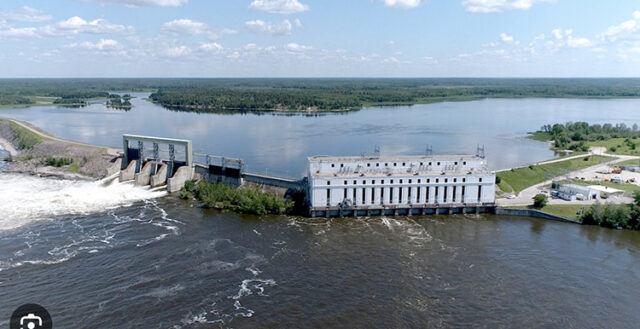By Winona LaDuke
The Pimicikamak Cree Nation in northern Manitoba is choking on smoke as fires rage through the territories, with 767 people trying to escape the worst fires in history. The skies are filled with smoke here even, and the sun has been red in the sky for days. It’s really a terrifying feeling, that is hard to escape, it’s in our DNA to be fearful of catastrophe.
As the air particulates come to our land, and towns like Detroit Lakes and Grand Marais hit records for poor air quality, we go outside in masks or not at all .We are closer than we think. Some of our electricity comes from this very community, and the price is high. “Many that couldn’t get out because the junction at Highway 374 and Highway 373 is their lifeline to Norway House, and now it’s being compromised by the fire and the smoke,” said Chief David Monias, Chief of the Nation at Pimicikamak Okimawin – Cross Lake Band.
Terrifying. Pimicikamak is Cree territory of the north – Cross Lake it’s called. The word refers to a current cross the lake. It’s the same word as Bemidji – or Bemdjigaamag. The lake with a cross current. As I write, the airport is closed, roads and rivers compromised. Residents were being flown out from the bush airport, about 530 kilometers north of Winnipeg, but high winds and dry conditions worsened the situation, flights were cancelled without notice, just as Chief Monias issued a full evacuation order, telling the remaining 6,500 residents of the territory to head south to Norway House Cree Nation.
That’s another community is under an evacuation notice. While the media treats the raging fires as sort of an annual horror show, the background to these times has been building. Pimicikamak’s traditional territory is the upper Nelson River watershed, Kichi Sipi (Cree for Great River, or Mississippi). It drains the fourth largest watershed in North America. Lake Winnipeg, the seventh largest lake in North America, and two of the continent’s largest rivers.
There’s been a long assault on the integrity of that ecosystem, with Minnesotans as some of the primary beneficiaries. What am I talking about? Manitoba Hydro and the mega dams. Hydro electric power has been misrepresented as clean energy – but that’s a matter of scale. Drowning entire ecosystems under water, creating wastelands of dead trees, and receding shoreline, silting and clogging dams till they are inefficient.
Ecologically, the extensive boreal shoreline ecosystem nourishes the vast forests of the north and that destruction has a large ripple for the boreal forest. The boreal forest is an ecological stronghold remaining in North America. It is the northern lung of the planet, covering 40% of Canada’s land mass (and part of it is in Russia). It may be as important as the world’s rainforests (the other lung) in producing oxygen and absorbing greenhouse gases. But the boreal forest is now the most threatened of all major landscapes on our planet according to William Pruitt, at the University of Manitoba.
In Manitoba alone, hydro-electric development has resulted in the flooding or clearing of roughly 600,000 acres of boreal forest. That is roughly 10 times the area lost to clear-cutting in Canada annually. In addition, an unknown area of forest is lost each year as destabilized land is dumped into rivers and lakes by erosion. Canada is the world’s largest producer of hydroelectricity. The people who are dammed are Indigenous – a way of life buried under huge dams.
“Our people are grieving; they are grieving for land, the water and a way of life that was brought to an abrupt halt. I remember going along the shoreline to pick medicine with my late grandmother only to find it flooded. My grandmother stood there crying because that was her life. Her life was the land.”said Bobby Brightnose, traditional healer told a reporter.
“Millions of tons of earth wash into the rivers and lakes from shoreline erosion each year; erosion of burial sites continues to take place. Historic camp sites are washed away. Entire islands disappear. Spawning grounds have been destroyed. Wildlife has become scarce. Navigation has become hazardous. Our people feel and fear the effects day after day, week after week, year after year.” Nelson Miller, Pimicikamak Executive Council, said.
The response: “…it’s just the cost of doing business,” Manitoba Hydro President and CEO said, in regard to the 1994 death of a Pimicikamak citizen in a boating accident caused by Manitoba Hydro’s hydro-electric project. Who has benefited? That would be the US. The north has dams, and the powerlines go south. That’s what an energy colony looks like, and money is to be made. One of the largest contracts with Manitoba Hydro is with XCEL Energy. That, however, is about to change. Between Trump’s Trade War with Canada, and a visionary Premier of Manitoba – Wab Kinew, the first Anishinaabe Premier of Manitoba, the XCEL contracts will not be renewed.
On Aprii 14, Kinew announced that Manitoba Hydro would not renew two contracts totaling 500 megawatts of power capacity to XCEL. Instead, Manitoba has decided to export power to Nunavut, a largely Indigenous Province further north.
One more point. These fires are the direct result of fossil fuel combustion. Between Canada’s dirty tar sands, and Enbridge, there’s an ecological mess being made. Far away, those fires, but the smoke is in my lungs, scorches my throat and my primal fears are at an all-time high.
Pimicikamik, I pray for you.







